2017 Hyundai Santa Fe Sport engine coolant
[x] Cancel search: engine coolantPage 525 of 614
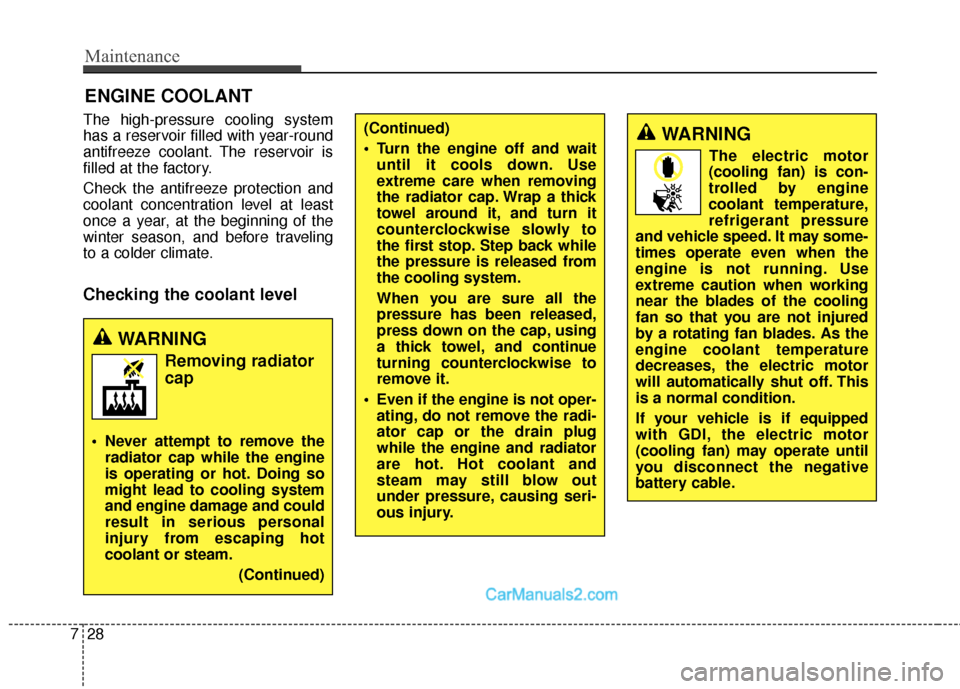
Maintenance
28
7
ENGINE COOLANT
The high-pressure cooling system
has a reservoir filled with year-round
antifreeze coolant. The reservoir is
filled at the factory.
Check the antifreeze protection and
coolant concentration level at least
once a year, at the beginning of the
winter season, and before traveling
to a colder climate.
Checking the coolant level
(Continued)
Turn the engine off and wait
until it cools down. Use
extreme care when removing
the radiator cap. Wrap a thick
towel around it, and turn it
counterclockwise slowly to
the first stop. Step back while
the pressure is released from
the cooling system.
When you are sure all the
pressure has been released,
press down on the cap, using
a thick towel, and continue
turning counterclockwise to
remove it.
Even if the engine is not oper- ating, do not remove the radi-
ator cap or the drain plug
while the engine and radiator
are hot. Hot coolant and
steam may still blow out
under pressure, causing seri-
ous injury.WARNING
The electric motor
(cooling fan) is con-
trolled by engine
coolant temperature,
refrigerant pressure
and vehicle speed. It may some-
times operate even when the
engine is not running. Use
extreme caution when working
near the blades of the cooling
fan so that you are not injured
by a rotating fan blades. As the
engine coolant temperature
decreases, the electric motor
will automatically shut off. This
is a normal condition.
If your vehicle is if equipped
with GDI, the electric motor
(cooling fan) may operate until
you disconnect the negative
battery cable.
WARNING
Removing radiator
cap
Never attempt to remove the radiator cap while the engine
is operating or hot. Doing so
might lead to cooling system
and engine damage and could
result in serious personal
injury from escaping hot
coolant or steam.
(Continued)
Page 526 of 614
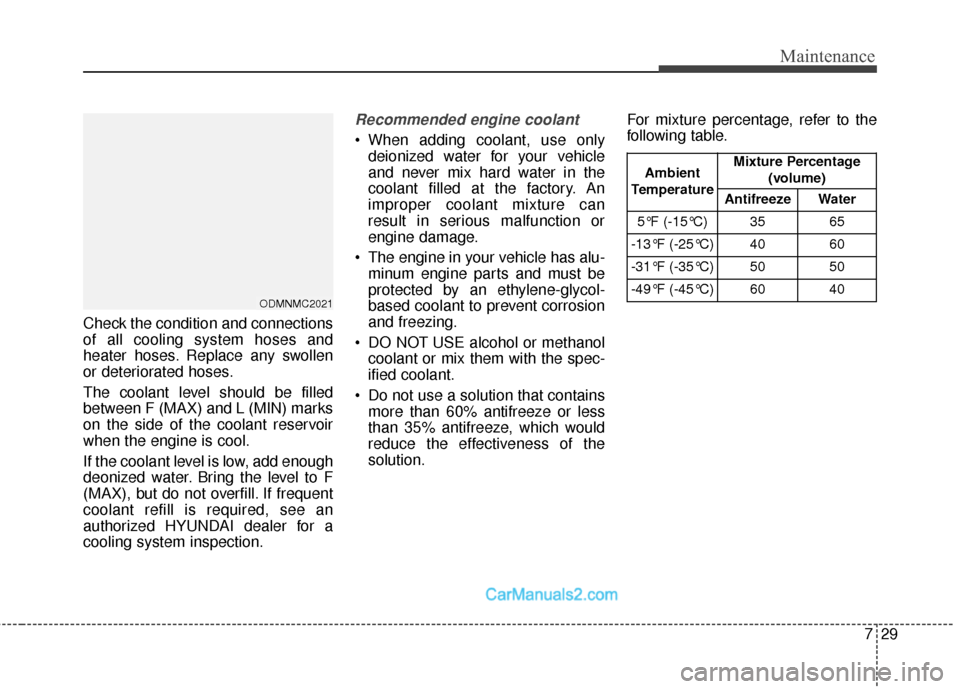
729
Maintenance
Check the condition and connections
of all cooling system hoses and
heater hoses. Replace any swollen
or deteriorated hoses.
The coolant level should be filled
between F (MAX) and L (MIN) marks
on the side of the coolant reservoir
when the engine is cool.
If the coolant level is low, add enough
deonized water. Bring the level to F
(MAX), but do not overfill. If frequent
coolant refill is required, see an
authorized HYUNDAI dealer for a
cooling system inspection.
Recommended engine coolant
When adding coolant, use onlydeionized water for your vehicle
and never mix hard water in the
coolant filled at the factory. An
improper coolant mixture can
result in serious malfunction or
engine damage.
The engine in your vehicle has alu- minum engine parts and must be
protected by an ethylene-glycol-
based coolant to prevent corrosion
and freezing.
DO NOT USE alcohol or methanol coolant or mix them with the spec-
ified coolant.
Do not use a solution that contains more than 60% antifreeze or less
than 35% antifreeze, which would
reduce the effectiveness of the
solution. For mixture percentage, refer to the
following table.
ODMNMC2021
Ambient
Temperature Mixture Percentage
(volume)
Antifreeze Water
5°F (-15°C) 35 65
-13°F (-25°C) 40 60
-31°F (-35°C) 50 50
-49°F (-45°C) 60 40
Page 527 of 614
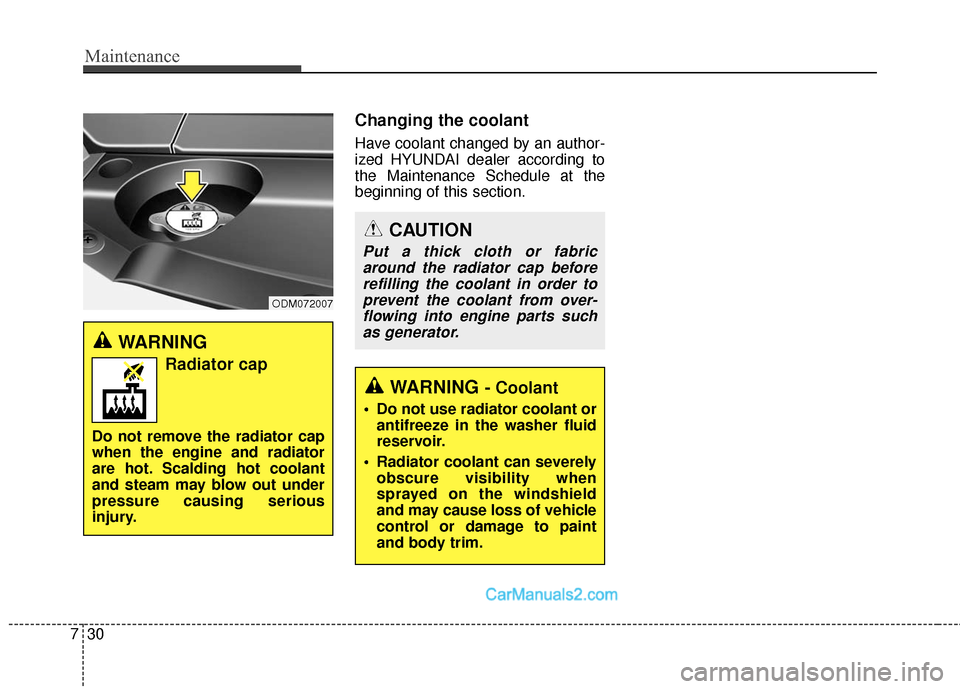
Maintenance
30
7
Changing the coolant
Have coolant changed by an author-
ized HYUNDAI dealer according to
the Maintenance Schedule at the
beginning of this section.
WARNING
Radiator cap
Do not remove the radiator cap
when the engine and radiator
are hot. Scalding hot coolant
and steam may blow out under
pressure causing serious
injury.
CAUTION
Put a thick cloth or fabric
around the radiator cap beforerefilling the coolant in order toprevent the coolant from over-flowing into engine parts suchas generator.
WARNING - Coolant
Do not use radiator coolant or antifreeze in the washer fluid
reservoir.
Radiator coolant can severely obscure visibility when
sprayed on the windshield
and may cause loss of vehicle
control or damage to paint
and body trim.
ODM072007
Page 587 of 614
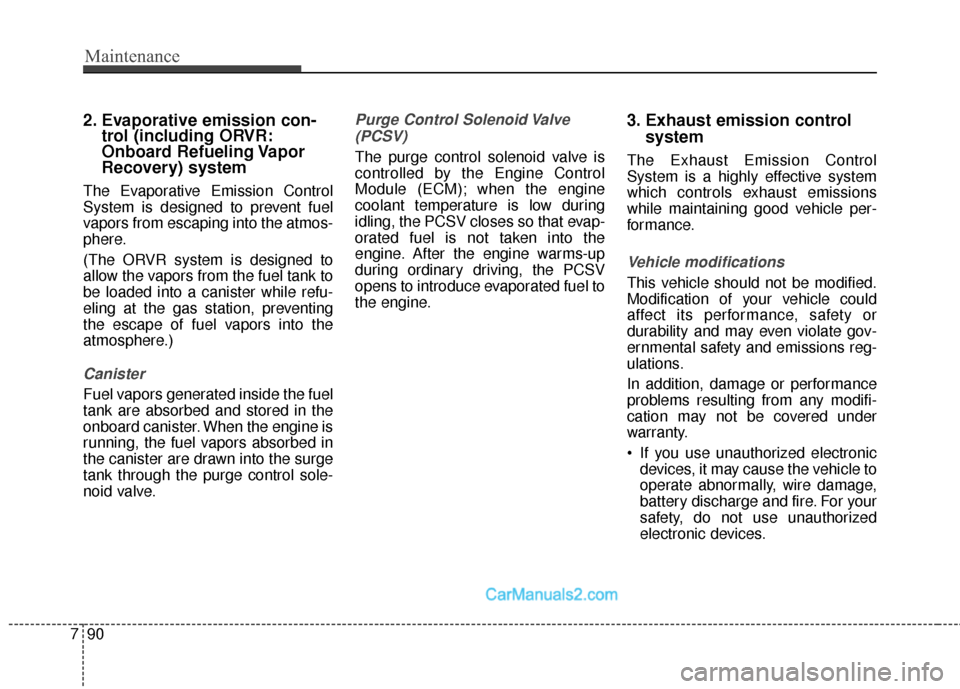
Maintenance
90
7
2. Evaporative emission con-
trol (including ORVR:
Onboard Refueling Vapor
Recovery) system
The Evaporative Emission Control
System is designed to prevent fuel
vapors from escaping into the atmos-
phere.
(The ORVR system is designed to
allow the vapors from the fuel tank to
be loaded into a canister while refu-
eling at the gas station, preventing
the escape of fuel vapors into the
atmosphere.)
Canister
Fuel vapors generated inside the fuel
tank are absorbed and stored in the
onboard canister. When the engine is
running, the fuel vapors absorbed in
the canister are drawn into the surge
tank through the purge control sole-
noid valve.
Purge Control Solenoid Valve
(PCSV)
The purge control solenoid valve is
controlled by the Engine Control
Module (ECM); when the engine
coolant temperature is low during
idling, the PCSV closes so that evap-
orated fuel is not taken into the
engine. After the engine warms-up
during ordinary driving, the PCSV
opens to introduce evaporated fuel to
the engine.
3. Exhaust emission control system
The Exhaust Emission Control
System is a highly effective system
which controls exhaust emissions
while maintaining good vehicle per-
formance.
Vehicle modifications
This vehicle should not be modified.
Modification of your vehicle could
affect its performance, safety or
durability and may even violate gov-
ernmental safety and emissions reg-
ulations.
In addition, damage or performance
problems resulting from any modifi-
cation may not be covered under
warranty.
If you use unauthorized electronic
devices, it may cause the vehicle to
operate abnormally, wire damage,
battery discharge and fire. For your
safety, do not use unauthorized
electronic devices.
Page 596 of 614
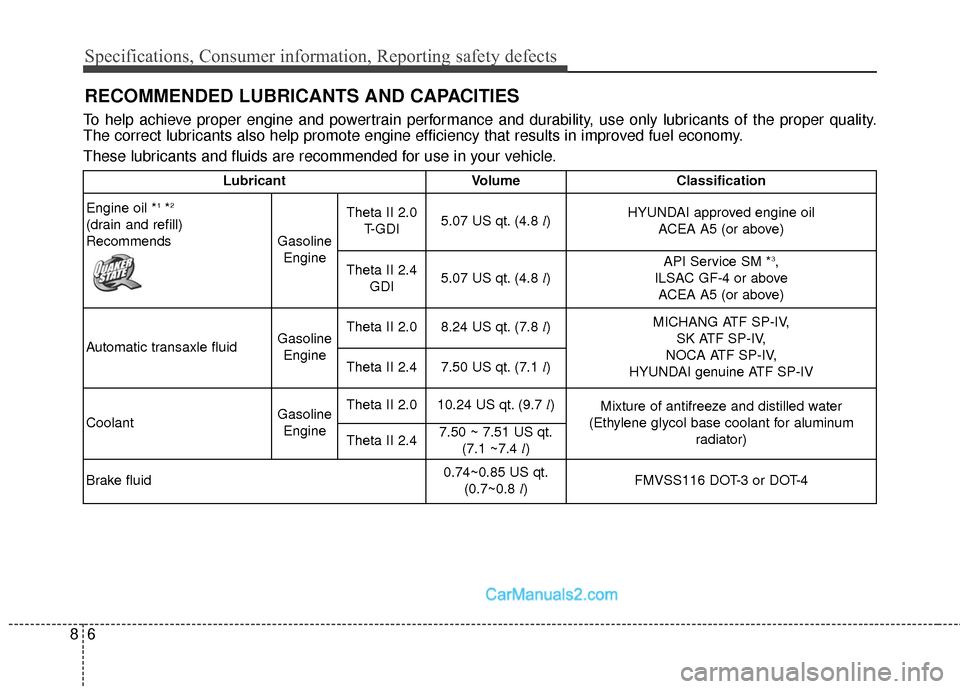
Specifications, Consumer information, Reporting safety defects
68
RECOMMENDED LUBRICANTS AND CAPACITIES
To help achieve proper engine and powertrain performance and durability, use only lubricants of the proper quality.
The correct lubricants also help promote engine efficiency that results in improved fuel economy.
These lubricants and fluids are recommended for use in your vehicle.
LubricantVolumeClassification
Engine oil *
1*2
(drain and refill)
Recommends Gasoline EngineTheta II 2.0
T-GDI 5.07 US qt. (4.8
l)HYUNDAI approved engine oil
ACEA A5 (or above)
Theta II 2.4 GDI 5.07 US qt. (4.8
l) API Service SM *
3,
ILSAC GF-4 or above ACEA A5 (or above)
Automatic transaxle fluid Gasoline
Engine Theta II 2.0
8.24 US qt. (7.8
l) MICHANG ATF SP-IV,
SK ATF SP-IV,
NOCA ATF SP-IV,
HYUNDAI genuine ATF SP-IV
Theta II 2.4
7.50 US qt. (7.1
l)
Coolant Gasoline
Engine Theta II 2.0
10.24 US qt. (9.7
l)
Mixture of antifreeze and distilled water
(Ethylene glycol base coolant for aluminum radiator)
Theta II 2.4 7.50 ~ 7.51 US qt.
(7.1 ~7.4 l)
Brake fluid 0.74~0.85 US qt.
(0.7~0.8 l) FMVSS116 DOT-3 or DOT-4
Page 605 of 614
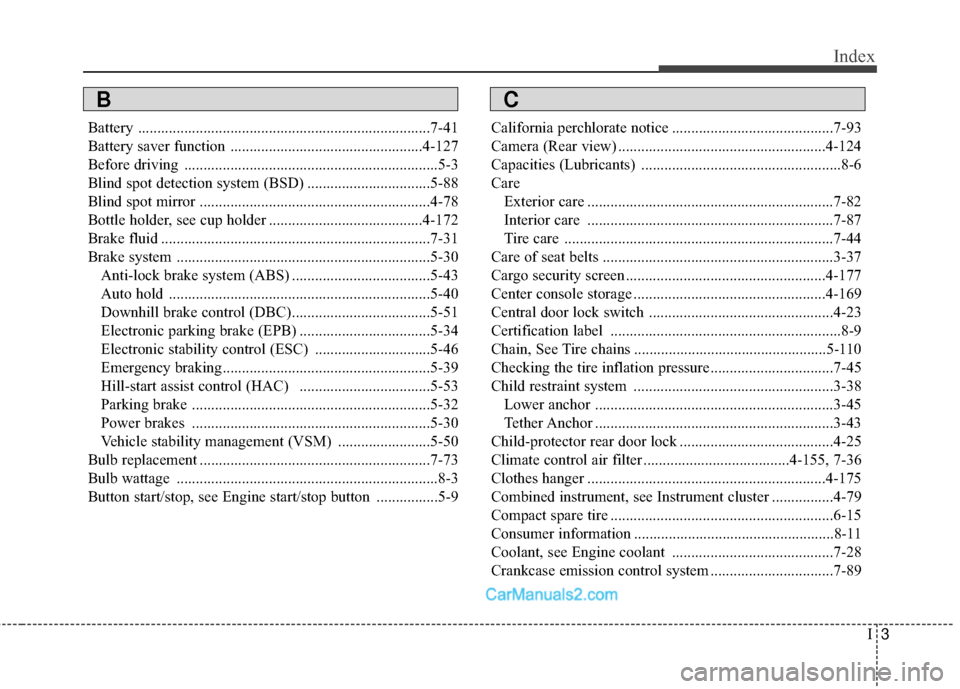
I3
Index
Battery ........................................................................\
....7-41
Battery saver function ..................................................4-127
Before driving ..................................................................5-3
Blind spot detection system (BSD) ................................5-88
Blind spot mirror ............................................................4-78
Bottle holder, see cup holder ........................................4-172
Brake fluid ......................................................................7-\
31
Brake system ..................................................................5-30Anti-lock brake system (ABS) ....................................5-43
Auto hold ....................................................................5-40\
Downhill brake control (DBC)....................................5-51
Electronic parking brake (EPB) ..................................5-34
Electronic stability control (ESC) ..............................5-46
Emergency braking......................................................5-39
Hill-start assist control (HAC) ..................................5-53
Parking brake ..............................................................5-32
Power brakes ..............................................................5-30
Vehicle stability management (VSM) ........................5-50
Bulb replacement ............................................................7-73
Bulb wattage ....................................................................8-3
Button start/stop, see Engine start/stop button ................5-9 California perchlorate notice ..........................................7-93
Camera (Rear view) ......................................................4-124
Capacities (Lubricants) ....................................................8-6
Care
Exterior care ................................................................7-82
Interior care ................................................................7-87
Tire care ......................................................................7-\
44
Care of seat belts ............................................................3-37
Cargo security screen ....................................................4-177
Center console storage ..................................................4-169
Central door lock switch ................................................4-23
Certification label ............................................................8-9
Chain, See Tire chains ..................................................5-110
Checking the tire inflation pressure ................................7-45
Child restraint system ....................................................3-38 Lower anchor ..............................................................3-45
Tether Anchor ..............................................................3-43
Child-protector rear door lock ........................................4-25
Climate control air filter ......................................4-155, 7-36
Clothes hanger ..............................................................4-175
Combined instrument, see Instrument cluster ................4-79
Compact spare tire ..........................................................6-15
Consumer information ....................................................8-11
Coolant, see Engine coolant ..........................................7-28
Crankcase emission control system ................................7-89
BC
Page 606 of 614
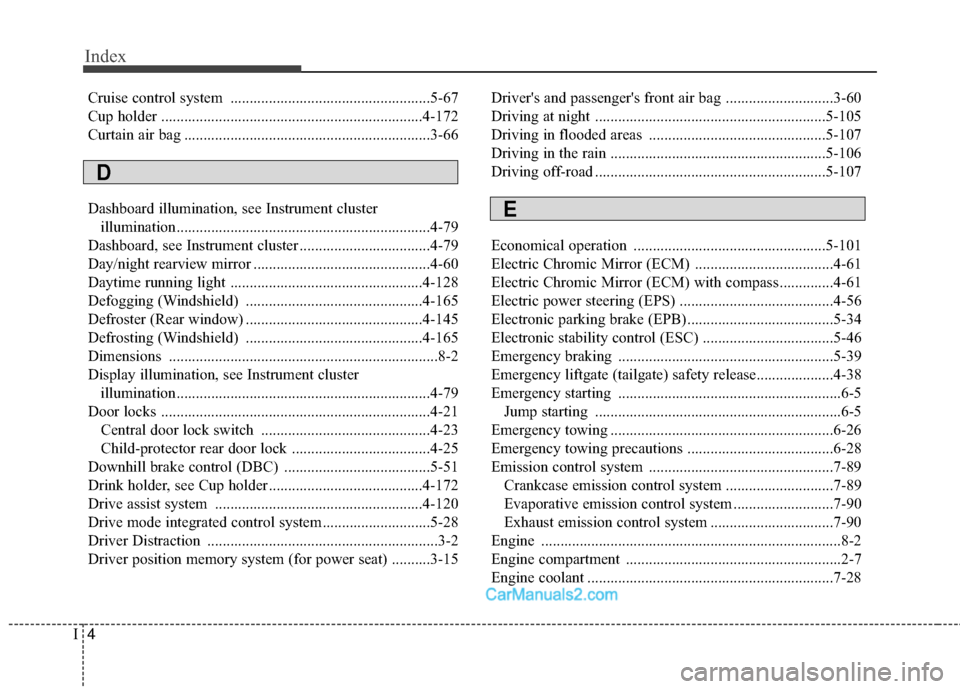
Index
4I
Cruise control system ....................................................5-67
Cup holder ....................................................................4-17\
2
Curtain air bag ................................................................3-66
Dashboard illumination, see Instrument cluster illumination..................................................................4-79
Dashboard, see Instrument cluster ..................................4-79
Day/night rearview mirror ..............................................4-60
Daytime running light ..................................................4-128
Defogging (Windshield) ..............................................4-165
Defroster (Rear window) ..............................................4-145
Defrosting (Windshield) ..............................................4-165
Dimensions ......................................................................8-\
2
Display illumination, see Instrument cluster illumination..................................................................4-79
Door locks ......................................................................4-\
21 Central door lock switch ............................................4-23
Child-protector rear door lock ....................................4-25
Downhill brake control (DBC) ......................................5-51
Drink holder, see Cup holder ........................................4-172
Drive assist system ......................................................4-120
Drive mode integrated control system ............................5-28
Driver Distraction ............................................................3-2
Driver position memory system (for power seat) ..........3-15 Driver's and passenger's front air bag ............................3-60
Driving at night ............................................................5-105
Driving in flooded areas ..............................................5-107
Driving in the rain ........................................................5-106
Driving off-road ............................................................5-107
Economical operation ..................................................5-101
Electric Chromic Mirror (ECM) ....................................4-61
Electric Chromic Mirror (ECM) with compass ..............4-61
Electric power steering (EPS) ........................................4-56
Electronic parking brake (EPB) ......................................5-34
Electronic stability control (ESC) ..................................5-46
Emergency braking ........................................................5-39
Emergency liftgate (tailgate) safety release....................4-38
Emergency starting ..........................................................6-5
Jump starting ................................................................6-5
Emergency towing ..........................................................6-26
Emergency towing precautions ......................................6-28
Emission control system ................................................7-89 Crankcase emission control system ............................7-89
Evaporative emission control system ..........................7-90
Exhaust emission control system ................................7-90
Engine ........................................................................\
......8-2
Engine compartment ........................................................2-7
Engine coolant ................................................................7-28
D
E